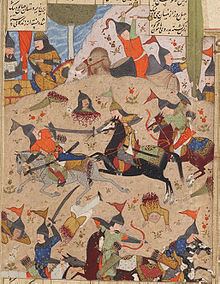An army larger than Ardashir I's army 10,000 cavalry Result Decisive Sasanian victory | Date 24 April 224 AD Location Shushtar, Iran | |
 | ||
Similar Battle of Resaena, Siege of Shushtar, Anastasian War, Battle of Samarra, Lazic War | ||
Battle of hormozdg n
The Battle of Hormozdgān was the climactic battle between the Parthian and the Sassanid Empires that took place on April 28, 224 AD. The Sassanid victory broke the power of the Arsacid dynasty, effectively ending almost five centuries of Parthian rule in Iran, the rest of the Middle East, the Caucasus, and Central Asia.
Contents
History
The battle was the culmination of rivalry between Ardashir I son of Papak, Parthian vassal king of Persis and his overlord, Shahanshah Artabanus V of Parthia. Ardashir ascended the throne of Persis in 208 AD after deposing his elder brother, Shapur. He immediately started expanding his domains and quickly conquered neighboring provinces of Kerman, Isfahan, Susiana (modern Khuzestan), and Mesene (modern Maysan). This expansion brought the attention of the Arscacid Great King Artabanus V (reign 216–224 AD).
After a period of negotiation and maneuvering, war became inevitable. Ardashir moved his army into Khuzestan in the spring of 224 AD and took a favorable position in the field of Hormozdgān, near the modern Iranian city of Shushtar. His position allowed him to control the water supplies on the field. Artabanus moved with his army from the Arsacid capital of Ctesiphon in Mesopotamia, and had to take a less favorable position with limited access to water. What we know about the battle is based on biased Sassanian sources. The two armies clashed on April 28, 224 AD. Sassanian records indicate that the battle was over the same day.
The manpower of the two armies as well as the number of casualties are unknown. We can speculate that both commanders fielded large numbers of cavalry. We may also speculate that both armies deployed horse archers in large numbers. Yet, it is reasonable to expect that at least Ardashir had some infantry on the field. It is also highly probable that both commanders relied on the shock effect of their core force of cataphracts to break the enemy line. What we know is that some Parthian forces defected to the Sassanid side, and Artabanus was killed in the battle. Sassanid sources picture Ardashir as the victor of a hand-to-hand combat with Artabanus. Given the mode of Iranian warfare, with its emphasis on protecting the commanders at any price, this claim may be apocryphal.
Ardashir's son, prince Shapur (later Shapur I of Persia) was present on the field and based on rock relief evidence, led the Persian heavy cavalry.
